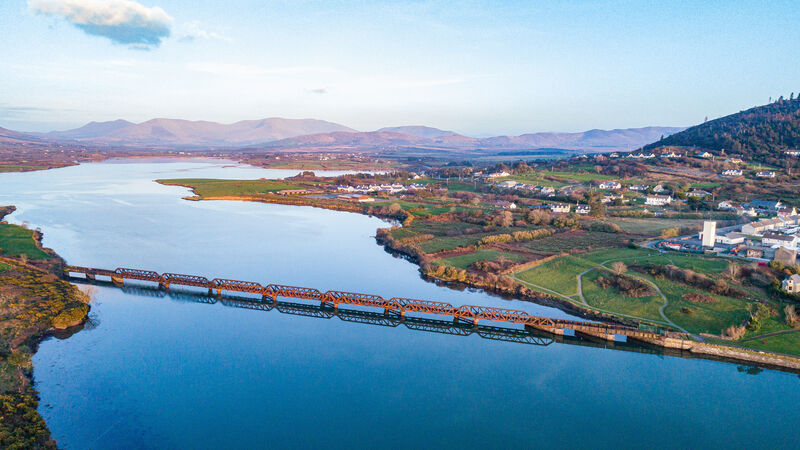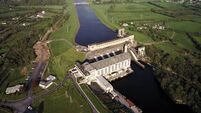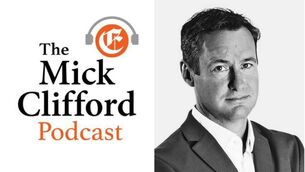John G O'Dwyer: Tourism on right track in Kerry as greenway gets green light

The South Kerry Greenway gets the Green Light after years of waiting. Pictured here the old Railway Bridge at the entrance to Cahersiveen Town. Photo Alan Landers.
A huge sigh of relief will doubtless have been exhaled by hard-hit tourism interests on Kerry’s Iveragh Peninsula with the announcement that the South Kerry Greenway has finally been given the green light.
Small towns such as Glenbeigh and Cahersiveen are now likely to see the type of transformation brought about for Kilmacthomas by the Waterford Greenway and for Mayo’s Mulranny by the Great Western Greenway. Moving from being merely convenient coffee stops for those circuiting the Ring of Kerry, these centres are now likely to become vibrant locations for food, accommodation and bike hire.
The battle to obtain planning permission for the new route — which largely follows the track-bed of the disused Glenbeigh to Cahersiveen railway — has, however, been a long and often bitter one.
While other trails such as Mayo’s Great Western Greenway were brought about in cooperation with local farmers, who allowed permissive access through their lands, the South Kerry model was based on acquiring State ownership.
When voluntary agreement could not be reached with landowners about the exact route of the greenway — the trail splits over 70 farm holdings — Kerry County Council decided to compulsorily purchase the required land. This had the effect of entrenching local opposition.
For almost a decade, the project was bogged down by access issues and legal challenges that ascended to the Supreme Court. Thankfully, confrontations such as these are rare.
Despite suggestions that access issues abound across the Irish countryside, the reality is that they are relatively few and mostly arise from local circumstances.
Having rambled in virtually every corner of Ireland, I can vouch that walkers are allowed unhindered access to virtually all our major highlands and scenic locations.
Primarily, this arises from the goodwill of landowners. The majority gain nothing except occasional hassles from allowing recourse to our upland and wilderness areas, but generously take no steps to prevent access, even though they are fully entitled to do so.
The result of this permissive access has been that in 2019, 2,392,000 overseas visitors to Ireland engaged in hiking and cross-country walking. Add in the almost three million domestic holidaymakers who also hiked and walked, and the value of outdoor recreation to our economy becomes strikingly apparent.
The old saying “there is gold in them dar hills” certainly carries a ring of truth, but not, it seems, for the communities involved. What became apparent recently when visiting the Irish countryside to research my latest book, , was the steep economic decline of rural villages.
An inevitable consequence has been the loss of vital services such as banks, post offices, and shops. In some areas, I found it impossible to obtain accommodation and was forced to retreat to the nearest town because local guesthouses had gone out of business as visitor spending urbanised itself.
An exception was in areas where tourism had taken root. Here, accommodation and quality local cuisine were readily available, along with all the services needed to maintain a viable community.
The disproportionate value of tourism for rural communities was abundantly clear and proof, if proof were needed, that the hospitality industry, along with locally branded food, is the key to regenerating the Irish countryside.
The thousands who have responded with their feet to the Cliffs of Moher Coastal Path since it reopened is a clear demonstration of Ireland’s potential as a walking destination. The Great Western Greenway, the Sheep’s Head Way, the Spinc Boardwalk in Glendalough, and more recently St Declan’s Way, are other examples of well-focused products using the countryside to energise visitor demand.
The unifying theme arising for all the above is that their development was based on a consensus with local landowners. The South Kerry Greenway stands as an exception and will, we can only hope, remain a singular example.
Harsh lessons have been learned on all sides of this dispute about how access issues can split communities, add huge costs and greatly delay product delivery. Meaningful engagement between all parties involved is the best way to avoid protracted court battles that, in the long run, serve the interests of no one.
Recourse to privately-owned land is best achieved by permissive access, which most often is generously allowed. This is by far the best way to maintain the goodwill of local landowners and rural communities.
- John G O’Dwyer latest book is published in April by Currach Books.













